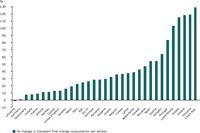
The figure shows the change in transport final energy consumption per person (1990-2008) in %

Based on the ratio : energy consumption / population (%/year calculated on the period 1990-2008)

Unit consumption per employee is the ratio between the energy consumption (total or electricity) and the number of employees (salaries employed in full time). The energy (or electricity) intensity is the ratio between the energy (electricity) consumption and the value added expressed in constant Euros (M€2000)

Unit consumption per employee is the ratio between the energy consumption (total or electricity) and the number of employees (salaries employed in full time). The energy (or electricity) intensity is the ratio between the energy (electricity) consumption and the value added expressed in constant Euros (M€2000)

Unit consumption per employee is the ratio between the energy consumption (total or electricity) and the number of employees (salaries employed in full time). The energy (or electricity) intensity is the ratio between the energy (electricity) consumption and the value added expressed in constant Euros (M€2000)

The figure shows changes in the power of the European fishing fleet. Countries have been grouped into the following categories: EU15 - Belgium, Denmark, Germany, Greece, Spain, France, Ireland, Italy, Luxembourg, Netherlands, Austria, Portugal, Finland, Sweden, United Kingdom; EFTA: Iceland, Norway; EU7 - Estonia, Cyprus, Lithuania, Latvia, Malta, Poland and Slovenia; and Bulgaria and Romania

The figure shows the state of commercial fish stocks in the Mediterranean Sea. Status of fish stocks was assessed from 2001-2009 in the GFCM regions, although data refers to 2005.
Year in the cells refer to year of ICCAT or GFCM assessments.

The figure shows changes in the tonnage of the European fishing fleet. Countries have been grouped into the following categories: EU15 - Belgium, Denmark, Germany, Greece, Spain, France, Ireland, Italy, Luxembourg, Netherlands, Austria, Portugal, Finland, Sweden, United Kingdom; EFTA - Iceland, Norway; EU7 - Estonia, Cyprus, Lithuania, Latvia, Malta, Poland and Slovenia; and Bulgaria and Romania.

The figure shows the state of commercial fish stocks in North East Atlantic and Baltic Sea. Status of fish stocks was assessed in 2009 in the ICES regions , although data refers to 2008.
Elasmobranchs not included as they constitute only about 3% of the total catch in the NE Atlantic and consist of many species and stocks which would mask the general trend.

The figure shows the changes in the number of vessels of the European fishing fleet. Countries have been grouped into the following categories: EU15 - Belgium, Denmark, Germany, Greece, Spain, France, Ireland, Italy, Luxembourg, Netherlands, Austria, Portugal, Finland, Sweden, United Kingdom; EFTA - Iceland, Norway; EU7 - Estonia, Cyprus, Lithuania, Latvia, Malta, Poland and Slovenia; and Bulgaria and Romania

The figure shows changes in fishing fleet capacity and size between 1998 and 2008 in EU15 and EFTA countries. Countries have been grouped into the following categories: EU15 - Belgium, Denmark, Germany, Greece, Spain, France, Ireland, Italy, Luxembourg, Netherlands, Austria, Portugal, Finland, Sweden, United Kingdom; EFTA - Iceland, Norway.

The figure shows changes in fishing fleet capacity and size between 2004 and 2008 for EU7 and 2007 and 2008 for Bulgaria and Romania. Countries have been grouped into the following categories: EU7 - Estonia, Cyprus, Lithuania, Latvia, Malta, Poland and Slovenia; and Bulgaria and Romania.

The graph shows the change in emissions of primary PM10 data, and emissions of PM2.5.

The graph shows the change in energy-related emissions of ozone precursors (NOx, NMVOC, CO and CH4) each weighted by an ozone formation factor prior to aggregation to represent their respective ozone forming potentials. The relative impact of the combined contribution of NOx, NMVOC, CO and CH4 to ozone formation can be assessed based on their tropospheric ozone forming potentials (TOFP): nitrogen oxides 1.22, non-methane volatile organic compounds 1.0, carbon monoxide 0.11 and methane 0.014 (de Leeuw 2002).

The figure shows the emission of NOx, NMVOC, CO and CH4 in 2008

Total gross inland energy consumption increased until 2004 in the EU-27It: it was about 10% above its 1990 level in 2004 (average growth of 0.7 % per year). Since 2004, it is has stopped growing: it was stable in 2005 and 2006 and decreased in 2007 and 2008 (by 1% and 0.5% respectively): as a result, the gross inland consumption was in 2008 1.4% below its 2004 level. Total gross inland energy consumption was in 2008 8.3% above its 1990 level.

Total gross inland energy consumption increased until 2004 in the EU-27It: it was about 10% above its 1990 level in 2004 (average growth of 0.7 % per year). Since 2004, it is has stopped growing: it was stable in 2005 and 2006 and decreased in 2007 and 2008 (by 1% and 0.5% respectively): as a result, the gross inland consumption was in 2008 1.4% below its 2004 level. Total gross inland energy consumption was in 2008 8.3% above its 1990 level.

Share of RE (RE: renewable energy) in GEIC (GEIC: gross energy inland consumption), compared to target in COM(97) 599 final (%, in 2008). The White Paper on renewable energy (COM(97) 599 final) sets an indicative target of 12 % of renewables in total GEIC in the EU-15 by 2010. The contribution of renewable energy sources to GEIC in EU-15 was 8.6 % in 2008, falling significantly short of the 12% indicative target

The table shows the share of renewable energy in total gross energy inland consumption (in %)

The figure shows the total primary energy consumption by energy source in 2008. The contribution of renewable energy sources to gross energy inland consumption (GEIC) increased in the EU-27 from 4.4 % in 1990 to 8.4 % in 2008. For the EU-15, the share of renewables in total gross inland consumption accounted for 8.6%, in 2008, falling substantially short of the indicative target set in the White Paper on renewable energy (COM(97) 599 final) of 12 % by 2010